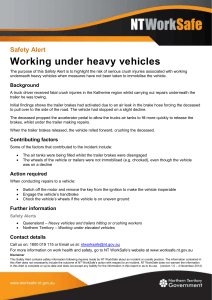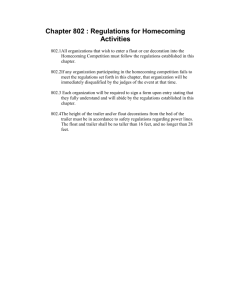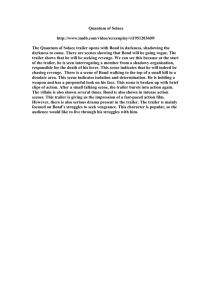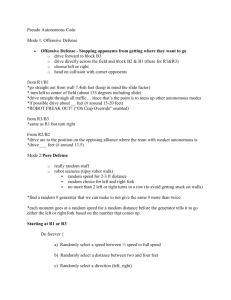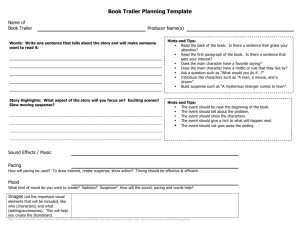Section 2 Driving safely Questions (sections 2.1 through 2.3) 1. What
advertisement
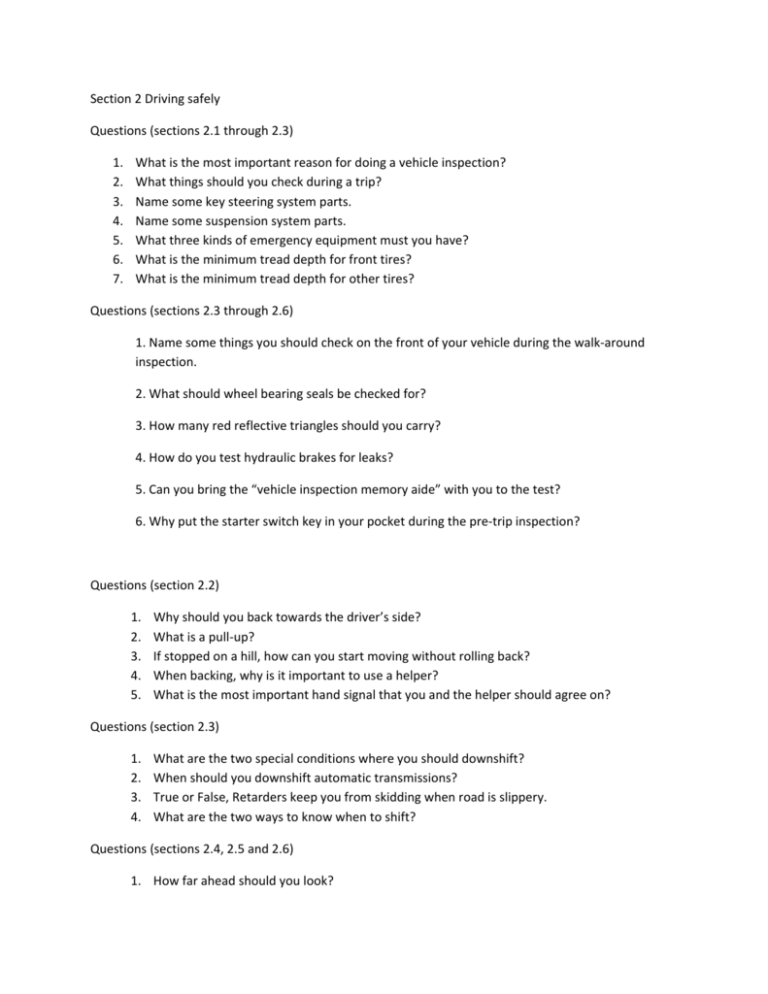
Section 2 Driving safely Questions (sections 2.1 through 2.3) 1. 2. 3. 4. 5. 6. 7. What is the most important reason for doing a vehicle inspection? What things should you check during a trip? Name some key steering system parts. Name some suspension system parts. What three kinds of emergency equipment must you have? What is the minimum tread depth for front tires? What is the minimum tread depth for other tires? Questions (sections 2.3 through 2.6) 1. Name some things you should check on the front of your vehicle during the walk‐around inspection. 2. What should wheel bearing seals be checked for? 3. How many red reflective triangles should you carry? 4. How do you test hydraulic brakes for leaks? 5. Can you bring the “vehicle inspection memory aide” with you to the test? 6. Why put the starter switch key in your pocket during the pre‐trip inspection? Questions (section 2.2) 1. 2. 3. 4. 5. Why should you back towards the driver’s side? What is a pull‐up? If stopped on a hill, how can you start moving without rolling back? When backing, why is it important to use a helper? What is the most important hand signal that you and the helper should agree on? Questions (section 2.3) 1. 2. 3. 4. What are the two special conditions where you should downshift? When should you downshift automatic transmissions? True or False, Retarders keep you from skidding when road is slippery. What are the two ways to know when to shift? Questions (sections 2.4, 2.5 and 2.6) 1. How far ahead should you look? 2. 3. 4. 5. 6. 7. 8. 9. 10. What are the two main things to look for ahead? What’s your most important way to see the sides and rear? What does “communicating” mean in safe driving? Where should your reflectors be placed when stopped on a divided highway? What three things add up to total stopping distance? If you go twice as fast, will your stopping distance increase by two or four times? True or False, empty trucks have the best braking. What is hydroplaning? What is “black ice”? Questions (section 2.7) 1. How do you find out how many seconds of following distance space you have? 2. If you are driving a 30 foot vehicle at 55 mph, how many seconds of following distance should you allow? 3. True or false, You should decrease your following distance if somebody is following you too closely. 4. True or false, If you swing wide to the left before turning right, another driver may try to pass you on the right. Questions (sections 2.8, 2.9, 2.10 and 2.11) 1. 2. 3. 4. 5. True or False, You should use low beams whenever you can. What should you do before you drive if drowsy? What effects can wet brakes cause? How can you avoid these problems? True or False, You should let air out of hot tires so the pressure goes back to normal. True or False, You can safely remove the radiator cap as long as the engine isn’t overheated. Questions (section 2.12, 2.13, and 2.14) 1. What factors determine your selection of a “safe” speed when going down a long, steep downgrade? 2. Why should you be in the proper gear before starting down a hill? 3. Describe the proper braking technique when going down a long, steep downgrade. 4. What is a hazard? 5. Why make emergency plans when you see a hazard? Questions (sections 2.15 and 2.16) 1. 2. 3. 4. True or False, Stopping is not always the safest thing to do in an emergency. What are some advantages of going right instead of left around an obstacle? What is an escape ramp? True or False, If a tire blows out, you should put the brakes on hard to stop quickly. Questions (sections 2.17 and 2.18) 1. 2. 3. 4. 5. What are some things to do at an accident scene to prevent another accident? Name two causes of tire fires. What kinds of fires is a B:C extinguisher not good for? When using your extinguisher, should you get as close as possible to the fire? Name some causes of vehicle fires. Questions (sections 2.19 and 2.20) 1. 2. 3. 4. 5. True or False, Common medicines for colds can make you sleepy. What should you do if you become sleepy while driving? True or False, Coffee and a little fresh air will help a drinker sober up. What is a hazardous materials placard? Why are placards used? Questions (section 3.3 and 3.4) 1. 2. 3. 4. What is the minimum number of tiedowns for any flat‐ bed load? What is the minimum number of tiedowns for a 20 foot load? Name two basic reasons for covering cargo on an open bed. What must you check before transporting a sealed load? Questions (sections 4.1 and 4.2) 1. 2. 3. 4. Name some things to check in the interior of a bus during a pre‐trip inspection. What are some hazardous materials you can transport by bus? What are some hazardous materials you can not transport by bus? What is a standee line? Questions (section 4.3, 4.4, 4.5 and 4.6) 1. 2. 3. 4. 5. Does it matter where you make a disruptive passenger get off the bus? How far from a railroad crossing should you stop? When must you stop before crossing a drawbridge? List some “prohibited practices” for the driver of a bus. True or False, The rear door of a transit bus has to be open to put on the parking brake. Questions (section 5.1) 1. 2. 3. 4. 5. Why must air tanks be drained? What is a supply pressure gauge used for? True or False, All vehicles with air brakes must have a low air pressure warning signal. What are spring brakes? True or False, Front wheel brakes are good under all conditions. Questions (section 5.2 and 5.3) 1. 2. 3. 4. 5. 6. What is a dual air brake system? What are slack adjusters? How can you check slack adjusters? How can you test the low pressure warning signal? What can you check to make sure the spring brakes will come on automatically? What are the maximum leakage rates? Questions (section 5.4) 1. Why should you be in the proper gear before starting down a hill? 2. What factors can cause brakes to fade or fail? 3. True or false, the use of brakes on a long steep downgrade is only a supplement to the braking effect of the engine. 4. True or False, If you are away from your vehicle only a short time, you don’t need to use the parking brake. 5. How often should you drain air tanks? Questions (section 6.1) 1. 2. 3. 4. 5. What two things are important to prevent rollover? When you turn suddenly while pulling doubles, which trailer is most likely to turn over? Why should you not use the trailer hand brake to straighten out a jackknifing trailer? What is offtracking? Why should you turn like it shows in Figure 6‐5? Questions (section 6.2) 1. 2. 3. 4. 5. 6. Why should you not use the trailer hand valve while driving? Describe what the trailer air supply control does. Describe what the service line is for. What is the emergency air line for? Why should you use chocks when parking a trailer without spring brakes? Where are shut‐off valves? Questions (section 6.3) 1. What might happen if the trailer is too high when you try to couple? 2. After coupling, how much space should be between the upper and lower fifth wheel? 3. True or false, You should look into the back of the fifth wheel to see if it is locked onto the kingpin. 4. True or false, To drive, you need to raise the landing gear only until it just lifts off the pavement. Questions (section 6.4) 1. 2. 3. 4. 5. Which shut‐off valves should be open and which should be closed? How can you test that air flows to all trailers? How can you test the tractor protection valve? How can you test the trailer emergency brakes? How can you test the trailer service brakes? Question (section 7.1, 7.2, 7.3 and 7.4) 1. 2. 3. 4. 5. 6. What is a converter dolly? Do converter dollies have spring brakes? What three methods can you use to secure a second trailer before coupling? How do you check to make sure trailer height is correct before coupling? What do you check when making a visual check of coupling? Why should you pull a dolly out from under a trailer before you disconnect it from the trailer in front? 7. What should you check for when inspecting the converter dolly? The pintle hook? 8. Should the shut‐off valves on the rear of the last trailer be open or closed? On the first trailer in a set of doubles? On the middle trailer of a set of triples? 9. How can you test that air flows to all trailers? Questions (section 8.2) 1. 2. 3. 4. 5. 6. How are bulkheads different than baffles? Should a tank vehicle take curves, on‐ramps or off‐ramps at the posted speed limits? How are smooth bore tankers different to drive than those with baffles? What three things determine how much liquid you can load? What is outage? What two reasons make special care necessary when driving tank vehicles?
